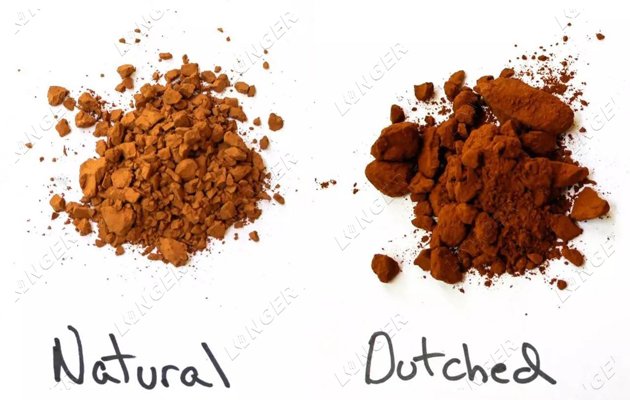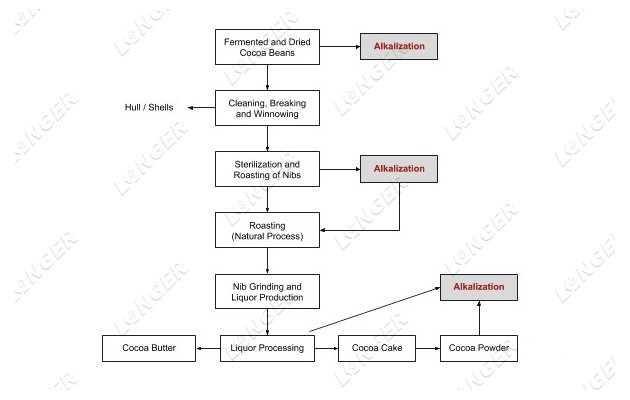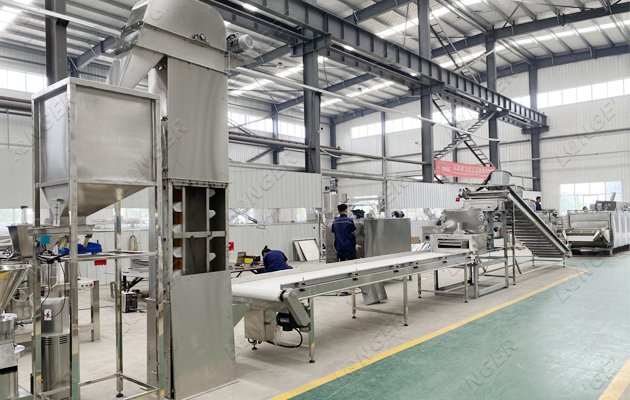This article mainly explains what is alkalized cocoa, what is the difference between alkalized cocoa and non-alkalized cocoa, and how to make alkalized cocoa. This article helps you learn more about the processing of alkalized cocoa.
Alkalized cocoa powder is added with edible alkali during the processing of cocoa beans, so as to achieve the purpose of adjusting the pH value. At the same time, the color of cocoa powder is also deepened, and the aroma is much stronger than that of natural cocoa powder.
The difference between natural cocoa beans and alkalized cocoa beans is whether or not to add edible alkali. Cocoa beans are naturally acidic after fermentation. The pH value is between 5.0 and 5.8, the color is light brown, and the solubility is about 30%. After melting, the solubility is better, the color is deeper, the natural sourness is less, the cocoa aroma is more mellow, and the price will be higher than that of natural powder.

What is the difference between unalkalized cocoa and alkalized cocoa?
Alkalized/dutched cocoa powder will darken in color, although the taste will improve and the taste will be more fragrant. This kind of cocoa powder is also the most on the market. The color of unalkalized cocoa powder is yellow-brown, which is more difficult to dissolve. The specific difference between unalkalized cocoa and alkalized cocoa can be seen in the following two specific explanations:
Difference between natural cocoa powder and alkalized cocoa powder:
1. Natural cocoa powder is a light brown cocoa powder produced without adding any additives during the processing of cocoa beans into cocoa powder with
cocoa powder production line; while alkalized cocoa powder is made by adding edible alkali during the processing of cocoa beans to adjust pH For the purpose of value, the color of cocoa powder is also deepened, and the aroma is much stronger than that of natural cocoa powder.
This is distinguished from the processing process, and ordinary people can't distinguish it. Let's compare it from the aspects of use and appearance.
2. The color of natural cocoa powder is lighter than alkalinized cocoa powder, and the aroma is not as strong as alkalinized cocoa powder. In use, alkalized cocoa powder should be used in a wide range. Generally speaking, natural cocoa powder is not used in the production of liquid products, let alone boiled water directly; alkalinized cocoa powder can be used in the production of any food, and it can also be taken directly. Because the cost of alkalized cocoa powder is higher than that of natural cocoa powder, the general food manufacturers basically use natural cocoa powder if they produce solid products; while producing liquid milk, beverages and other liquid products, they use alkalized cocoa powder. In the world, chocolate is basically produced with natural cocoa powder, while chocolate-flavored milk tea is produced with alkalized powder.
3. There is another important difference between natural cocoa powder and alkalized cocoa powder, that is, the pH value is different. The cocoa butter of cocoa powder has various specifications: 10~12%, 14~16%, 16~18%, 22~24%, and the one containing 10~12% cocoa butter is low-fat cocoa powder, cocoa powder contains oil The higher, the stronger the flavor. The pH value of natural cocoa powder is generally between 5.0 and 5.8; the pH value of alkalized cocoa powder is generally between 6.2 and 7.5.
Principle of alkalizability:
The alkalization process is equivalent to the deepening of the Maillard reaction, because natural cocoa is slightly acidic, and the pH is generally 5-5.6 by adding lye to adjust the acidic environment, which can make the reaction develop in a more powerful direction. Therefore, the alkalization process can further improve the quality of cocoa powder, deepen the color of cocoa powder, and increase the pH value of cocoa to 7-8. Because cocoa powder is widely used as a food ingredient in biscuits, chocolate drinks, pudding, cream, bonbons and ice cream, because of the different characteristics of each product, it is necessary to obtain cocoa powder with different colors through alkalization.

How to carry out the alkalization process of cocoa?
Alkalization treatment can be carried out at different stages of cocoa processing and in different states of cocoa, before roasting cocoa beans, during the process of cocoa nibs, after roasting cocoa beans, cocoa liquor and cocoa cake, in different processes. Implement.
Cocoa Soylation
The specific process of kernel alkalization: first roast the cocoa beans to break the bean kernels and separate the kernel shells, put the cocoa nibs into the alkalizer, and add a certain concentration of lye that has been configured, and mix it in the set The reaction is carried out at temperature, and the remaining water is removed after the full reaction, and the alkalized nibs are obtained.
The specific process is: adding the solution to the roasted cocoa bean meat, turning the roaster to dry for 2 hours, and then pulverizing into a liquid mass.
Cocoa Liquor Alkalization
The specific process of liquid mass alkalization: firstly grind the roasted cocoa nibs into liquid mass, put it into the alkalizer, and add a certain concentration of lye that has been configured, and after fully stirring it, in the set The reaction is carried out at temperature to obtain the alkalized cocoa liquor. Liquefaction alkalization is a more used method and is more economical. Generally, the lye should be added gradually in two times, mixed and alkalized. Maintaining a high temperature of the mixer is to prevent the liquid mass from sticking and to control the water content of the liquid mass, but the temperature should not exceed 115°C
Cocoa Powder Alkalization:
Specific process of powder alkalization: cocoa cake and cocoa butter are obtained by pressing cocoa liquid block. Cocoa powder is obtained after crushing cocoa cake. It is put into the Alkalizer and added with a certain concentration of alkali solution. After fully mixing, it reacts at the set temperature. After full reaction, the remaining water is removed to obtain the alkalized cocoa powder. Although the color of the alkalized cocoa powder is darker after alkalization, the cocoa flavor is not obvious and needs to be further improved. Some studies have found that adding flavor precursors to the alkalized powder can increase the flavor of cocoa through secondary baking.
Alkalized cocoa powder is still produced today and is the first choice for many food and beverage applications.
The following block diagram shows the various alkalization options in cocoa processing:

Alkalization of cocoa nibs (before grinding):
This is a traditional method and is believed to provide a high-quality product (other alkalization possibilities require more complicated conditions and may lead to undesirable lipid reactions). Once the device is filled with beans, the alkalization of the beans can be carried out in a drum reaction vessel (pressurized) and/or screw conveyor. 3
Alkalized Cocoa Processing steps:
1. Mix/soak. Mix the nib (6-7% moisture and at least 52% fat) with alkaline solution (sodium bicarbonate and water)
2. Heating. Heat the mixture for enough time for the color change to occur. Depending on the cocoa beans used and processing conditions (such as the concentration, pressure and time of the alkaline solution), a specific color will be produced.
3. Drying. After the heating step is complete, the mixture is dried and baked at a temperature below 100°C (212°F).
4. The same equipment (baking drum) can also be used for alkalization and baking.
 EN
EN
 Release Lime: 2021-09-07
Release Lime: 2021-09-07
 Source: Longer - Nut Processing Solution Provider
Source: Longer - Nut Processing Solution Provider


